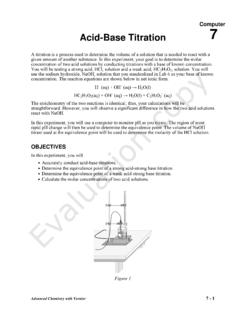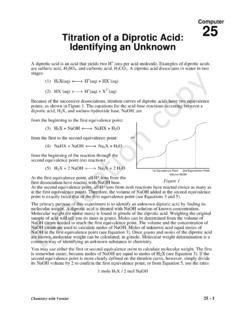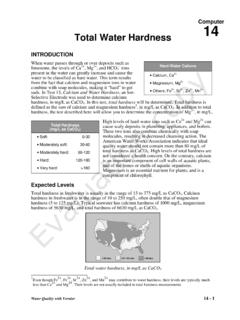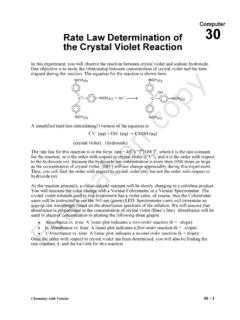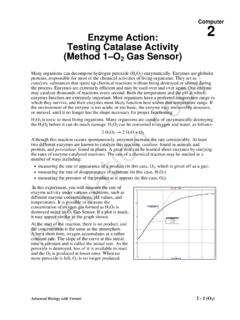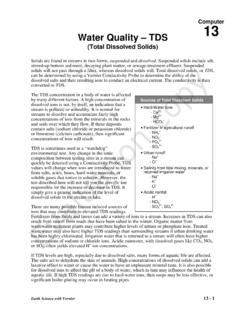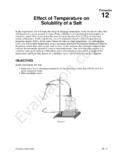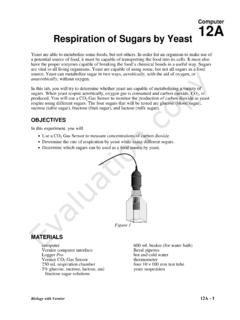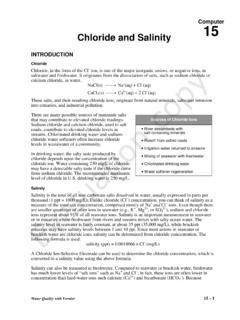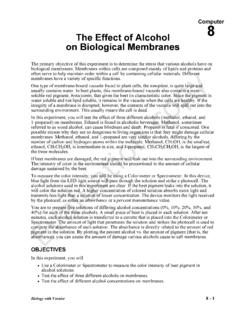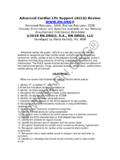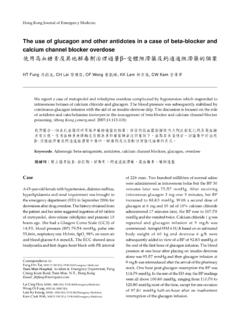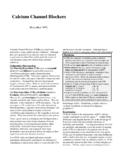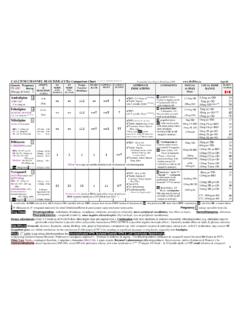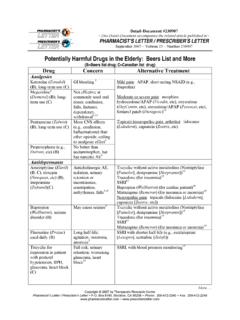Transcription of Computer 13 Calcium and Water Hardness
1 Computer 13 Water Quality with Vernier 13 - 1 Calcium and Water Hardness INTRODUCTION Calcium , Ca2+ Calcium , in the form of the Ca2+ ion, is one of the major inorganic cations, or positive ions, in saltwater and freshwater. It can originate from the dissociation of salts, such as Calcium chloride or Calcium sulfate, in Water . CaCl2(s) Ca2+(aq) + 2 Cl (aq) CaSO4(s) Ca2+(aq) + SO42 (aq) Most Calcium in surface Water comes from streams flowing over limestone, CaCO3, gypsum, CaSO4 2H2O, and other Calcium -containing rocks and minerals.
2 Groundwater and underground aquifers leach even higher concentrations of Calcium ions from rocks and soil. Calcium carbonate is relatively insoluble in Water , but dissolves more readily in Water containing significant levels of dissolved carbon The concentration of Calcium ions (Ca2+) in freshwater is found in a range of 0 to 100 mg/L, and usually has the highest concentration of any freshwater cation. A level of 50 mg/L is recommended as the upper limit for drinking Water . High levels are not considered a health concern; however, levels above 50 mg/L can be problematic due to formation of excess Calcium carbonate deposits in plumbing or in decreased cleansing action of soaps. If the Calcium -ion concentration in freshwater drops below 5 mg/L, it can support only sparse plant and animal life, a condition known as oligotrophic. Typical seawater contains Ca2+ levels of about 400 mg/L. Calcium Hardness as CaCO3 When Water passes through or over mineral deposits such as limestone, the levels of Ca2+, Mg2+, and HCO3 ions present in the Water greatly increase and cause the Water to be classified as hard Water .
3 This term results from the fact that Calcium or magnesium ions in Water combine with soap molecules, forming a sticky scum that interferes with soap action and makes it hard to get suds. One of the most obvious signs of Water Hardness is a layer of white film left on the surface of showers. Since most hard- Water ions originate from Calcium carbonate, levels of Water Hardness are often referred to in terms of Hardness as CaCO3. For example, if a Water sample is found to have a Ca2+ concentration of 30 mg/L, then its Calcium Hardness as CaCO3 can be calculated using the formula2 (30 mg/L Ca2+) x (100 g CaCO3 / 40 g Ca2+) = 75 mg/L Calcium Hardness as CaCO3 1 The reaction occurring with limestone is: CaCO3(s) + CO2(aq) + H2O(l) Ca2+(aq) + 2 HCO3 (aq). 2 This formula takes into account that the molar mass of Ca is 40 g/mol, and of CaCO3 is 100 g/mol.
4 Sources of Calcium Ions Limestone: CaCO3 Dolomite: CaCO3 MgCO3 Gypsum: CaSO4 2H2O Calcium Hardness as CaCO3 (mg/L) Soft: 0-20 Moderately soft: 20-40 Moderately hard: 40-80 Hard: 80-120 Very hard: > 120 Evaluation copy Computer 13 13 - 2 Water Quality with Vernier Note that 30 mg/L Ca2+ and 75 mg/L Calcium Hardness as CaCO3 are equivalent they are simply two different ways of expressing Calcium levels. The value of Calcium Hardness as CaCO3 can always be obtained by multiplying the Ca2+ concentration by a factor of 100/40, or Another common measurement of Water Hardness is known as total Hardness as CaCO3.
5 This measurement takes into account both Ca2+ and Mg2+ ions. On average, magnesium Hardness represents about 1/3 of total Hardness and Calcium Hardness about 2/3. If you are comparing your own test results of Calcium Hardness as CaCO3 with results in publications that use units of total Hardness as CaCO3, you can estimate total Hardness by multiplying the Calcium Hardness by See Test 14, Total Water Hardness , for further information about this topic. Expected Levels The concentration of Calcium ions (Ca2+) in freshwater is found in a range of 4 to 100 mg/L (10 250 mg/L of Calcium Hardness as CaCO3). Seawater contains Calcium levels of 400 mg/L Ca2+ (1000 mg/L of Calcium Hardness as CaCO3). Table 1: Calcium , Calcium Hardness , and Total Hardness in Selected Sites Site (fall season) Calcium (mg/L Ca2+) Ca Hardness (mg/L as CaCO3) Total Hardness (mg/L as CaCO3) Merrimack River, Lowell, NH Mississippi River, Memphis, TN Rio Grande River, El Paso, TX Ohio River, Grand Chain, OH Willamette River, Portland, OR Missouri River, Garrison Dam, ND Sacramento River, Keswick, CA Hudson River, Poughkeepsie, NY Platte River, Louisville, NE Colorado River, Andrade, CA Summary of Method A Vernier Calcium Ion-Selective Electrode (ISE) is used to measure the Calcium ion concentration in the Water , in mg/L as Ca2+, either on site or after returning to the lab.
6 This value is then multiplied by a factor of to obtain a value for Calcium Hardness as CaCO3, in mg/L. Calcium and Water Hardness Water Quality with Vernier 13 - 3 Calcium ION-SELECTIVE ELECTRODE Materials Checklist ___ Computer ___ Low Standard (10 mg/L Ca2+) ___ Vernier Computer interface ___ High Standard (1000 mg/L Ca2+) ___ Logger Pro ___ wash bottle with distilled Water ___ Calcium Ion-Selective Electrode ___ small paper or plastic cup (optional) ___ tissues Advanced Preparation The Vernier Calcium Ion-Selective Electrode (ISE) must be soaked in the Calcium High Standard solution (included with the ISE) for 15 30 minutes. Important: Make sure the ISE is not resting on the bottom, and that the small white reference contacts are immersed. Make sure no air bubbles are trapped below the ISE. If the ISE needs to be transported to the field during the soaking process, use the Short-Term ISE Soaking Bottle.
7 Remove the cap from the bottle and fill it 3/4 full with High Standard. Slide the bottle s cap onto the ISE, insert it into the bottle, and tighten. Important: Do not leave the ISE soaking for more than 24 hours. Long-term storage should be in the Long-Term ISE Storage Bottle. Collection and Storage of Samples 1. This test can be conducted on site or in the lab. A 100 mL Water sample is required. 2. It is important to obtain the Water sample from below the surface of the Water and as far away from shore as is safe. If suitable areas of the stream appear to be unreachable, samplers consisting of a rod and container can be constructed for collection. Refer to page Intro-4 of the Introduction of this book for more details. Testing Procedure 1. Position the Computer safely away from the Water . Keep Water away from the Computer at all times. 3. Prepare the Calcium Ion-Selective Electrode (ISE) for data collection.
8 A. The ISE should be soaking in the High Standard. Make sure that it is not resting on the bottom of the container, and that the small white reference contacts are immersed. b. Plug the ISE Sensor into Channel 1 of the Vernier interface. 2. Prepare the Computer for data collection by opening the file 13 Calcium & Hardness from the Water Quality with Vernier folder of Logger Pro. ISE soaking for travel Computer 13 13 - 4 Water Quality with Vernier 4. You are now ready to calibrate the Calcium ISE. First Calibration Point a. Choose Calibrate CH1: Calcium ISE (mg/L) from the Experiment menu and then click.
9 B. Type 1000 (the concentration in mg/L Ca2+) in the edit box. c. When the displayed voltage reading for Reading 1 stabilizes, click . Second Calibration Point d. Rinse the ISE thoroughly with distilled Water and gently blot it dry with a tissue. Be very gentle when blotting the membrane. Important: Failure to carefully rinse and dry the ISE will contaminate the standard. e. Place the tip of the ISE into the Low Standard (10 mg/L Ca2+). Be sure that the ISE is not resting on the bottom of the bottle and that the small white reference contacts are immersed. Make sure no air bubbles are trapped below the ISE. f. After briefly swirling the solution, hold the ISE still and wait approximately 30 seconds for the voltage reading displayed on the Computer screen to stabilize. g. Enter 10 (the concentration in mg/L Ca2+) in the edit box. h. When the displayed voltage reading for Reading 2 stabilizes, click , then click.
10 5. You are now ready to collect Calcium concentration data. a. Rinse the ISE with distilled Water and gently blot it dry. b. Place the tip of the probe into the stream at Site 1, or into a cup with sample Water from the stream. Make sure the ISE is not resting on the bottom and that the small white reference contacts are immersed. Make sure that no air bubbles are trapped below the ISE. c. Click to begin data collection. d. Click to begin a 10 s sampling run. Important: Leave the probe tip submerged for the 10 seconds that data is being collected. e. When the sampling run is complete, stop data collection and record the mean Calcium concentration value on the Data & Calculations sheet. 6. Return to Step 5 to obtain a second reading. 7. Convert the Calcium concentration (mg/L Ca2+) to units of Calcium Hardness (mg/L as CaCO3). The calculation takes into account the difference in the molar masses of Calcium (40 g/mol Ca2+) and Calcium carbonate (100 g/mol CaCO3).
